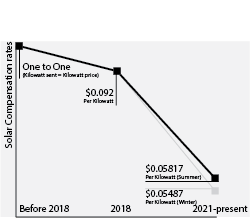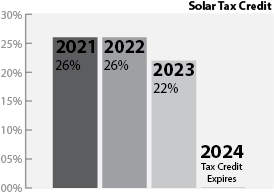Secretary General of the United Nations António Guterres has said the world needs to be carbon-neutral by 2050, and it’s sources like rooftop solar that will play a part in reaching that goal, while a 2020 report by the International Energy Association said solar is now the cheapest for of energy for consumers.

Unlike Germany and Australia, the United States hasn’t made solar as accessible.
“Rooftop solar in the United States costs three times more than it does in Germany and Australia, not because of the cost of the technology, but soft costs from permitting,” Benjamin Abbott, Brigham Young University’s assistant professor of environmental science and sustainability, said at the 2022 Intermountain Sustainability Summit. “This is a hesitancy by power providers to give up any of their monopoly on production.”
This continues to stem from companies like Rocky Mountain Power that have made significant cuts to solar incentives, leaving many homeowners buying systems that are less profitable, jeopardizing their return on investment and detracting from the value of their home.
Solar then vs. solar now
In the past, solar customers have been able to lock onto one-to-one net metering rates. When tracking the power produced by the panels versus the consumption of the home, the previous metering could turn a $150 monthly power bill into an $8 one.
“I put solar on my home back in 2012,” Jennifer Bodine, Weber State University’s sustainability manager, said. “My return on investment was seven years.”
One-to-one net metering ran during Rocky Mountain Power’s rate schedule 135 in 2017, an agreement made between the power company and solar owners. Homeowners who purchased their panels during this agreement are paid the same amount for a kilowatt hour they produce as they do for a kilowatt hour they consume. Their solar systems can offset the amount of power their home consumes, leaving just a few small Rocky Mountain Power fees on the homeowner’s monthly bill.
In addition, customers who signed on during this time were able to get 30% of their system cost covered by tax credits from the federal government. Things changed in 2018, however, during Rocky Mountain Power’s schedule 136.
“That was my driving factor on my timing,” Justin Owen, Weber State’s energy manager, said about his home’s solar system. “I saw the new proposal going to the Public Service Commission. I was like, ‘Well, if I’m going to do this, I’d better do it now.’”
Schedule 136 was considered a transition program by Rocky Mountain Power. Rather than having a one-to-one agreement, residents with solar would receive 9.2 cents per kilowatt hour their system produced.
Customers were locked into this 9.2 cent rate, meaning that even if kilowatt usage hour costs rose to 20 cents, the customer would still only be paid 9.2 cents per kilowatt hour their panels produced.
Lower than one-to-one, this net billing system was fairly comparable. Kilowatt usage hours still cost roughly that price, and during that agreement, the government covered 30% of a system’s cost. However, more rate-reductions in 2021 weakened the return on investment of panel-only systems.
Schedule 137 has been in effect since the beginning of 2021. The agreement dropped net billing rates from 9.2 cents per kilowatt hour and locked new customers into rates of 5.16 cents per kilowatt hour in the summer and 4.462 cents per kilowatt hour from October to May. Tax incentives also dropped from covering 30% of a system’s cost to 26%.
Rocky Mountain Power’s changes were brought on by many factors, but one was to roll out their Wattsmart Battery Program, a series of residential solar systems supported by backup batteries. These systems act as power plants, partially removing some of the workload that is currently on Rocky Mountain Power’s grid.
“One of the things we need is called grid neutrality,” Abbott said. “It’s beyond net metering and it actually says anyone can be a power producer on the grid if you meet certain criteria.”
Customers who enter the program are given a battery rebate from Rocky Mountain Power. Because these systems generate and hold power, solar owners can still have power during an outage. The power not going to the battery feeds the grid and Rocky Mountain Power and can draw 50% from customers’ batteries to maintain grid stability.
“Most batteries will have a programming built in to maximize self-consumption,” Owen said. “As soon as the sun goes down, they discharge into your home and you consume a bunch of solar power that you built up earlier in the day.”
The Wattsmart Battery Program may be the future of Rocky Mountain Power, but the future comes at a cost.
According to Rocky Mountain Power’s website, only Sonnen batteries qualify for the program, specifically the Core, the Eco and the EcoLinx.
While an LG Chem can cost $5,000-6,000 and a SolarEdge Energy Bank battery around $7,000, Sonnen batteries start around $10,000 and could be as much as $36,000, according to solarreviews.com. This doesn’t include system installation costs.
“Batteries do help because you can store that energy,” Bodine said. “But then the cost of batteries is still in the process of coming down.”

Panel-only systems in 2022
The cost of batteries, coupled with the rigorous criteria that solar companies need to meet to roll out the Wattsmart Battery program, leaves many still installing panel-only systems, including 1Solar.
Jake Kilgore, 1Solar’s chief executive officer, believes that the high price of batteries makes them impractical. However, the company will install a battery if asked, but none are in compliance with the Wattsmart Battery program.
Many of 1Solar’s installs are still panel-only systems. Despite the rapid decrease in net billing rates, Kilgore claims they can typically offset the cost of most systems.
“You go from $100 or $150 a month down to $8 or $10 a month is the expectation,” Kilgore said. “We can achieve that goal with our homes.”
With net metering decreasing, this is a difficult task in 2022.
“In order to get your bill all the way down like that, you’d actually have to produce more energy than you use,” Owen said. “[If] I’m exporting at 5.5 cents, I have to export a lot more than I consume to make up for that cost.”
According to a 2020 report from the Energy Information Administration, the average household in Utah consumes 769 kilowatt hours per month.
On Rocky Mountain Power’s current rate schedule, tier-one power (the first 400 kilowatt hours) costs a little over 9 cents in the summer, while tier-two power (power after that first 400 kilowatt hours) costs nearly 12 cents.
If a solar customer on schedule 137’s net billing rate used 769 kilowatt hours of power in the summer, their power bill would be roughly $83.52. Even if the panels produced 769 kilowatt hours of power, consumers would see only $38.45 taken off their bill.
With this math, Kilgore’s claims may seem far-fetched. An $8 power bill is still possible with a panel-only system under the current net-metering rates, but it may detract from a homeowner’s return on investment.
Kilgore said 1Solar tries to maximize roof space when designing their systems, adding to the size and price of the system.
Owen said that a home consuming 15,000 kilowatt hours a year (roughly 5,000 over the Utah average) would need a 10 kilowatt system to offset the energy, but a 15-18 kilowatt system to offset the cost. Also, that 15-18 kilowatt system may not offset the cost when rates rise.
“If I were in the industry right now, I would be all about maximizing return on investment for the customer,” Owen said. “I’d be getting them out of that tier two power, more expensive power as opposed to getting that bill down to the $8.50 minimum.”

Solar and real estate
Where Bodine only took seven years for her panels to start making her money, she said today’s typical homeowners are looking “past 10 years, maybe 15-20 years” to make a return on investment. According to Realtor Laurann Turner, this time frame is too long for the modern homeowner.
The average homeowner spends nine years in their home, according to Turner, who also said panels don’t add value to a home and may even detract from it.
“The only thing it does is lower your electric bill,” Turner said.
Turner has even had a buyer who demanded a home’s panels be taken off, costing the sellers around $5,000 in removal costs. She said this is a common scenario for homeowners who take a lease for their panels because buyers are wary of taking over that cost.
“The salespeople for solar are incredible,” Turner said. “The math doesn’t add up to me.”
It’s possible that the Wattsmart Battery program will make solar more practical for average homeowners one day, but for now, many people are only being educated about and purchasing outdated systems. According to Owen, homeowners thinking about solar should look to multiple companies for bids.




















